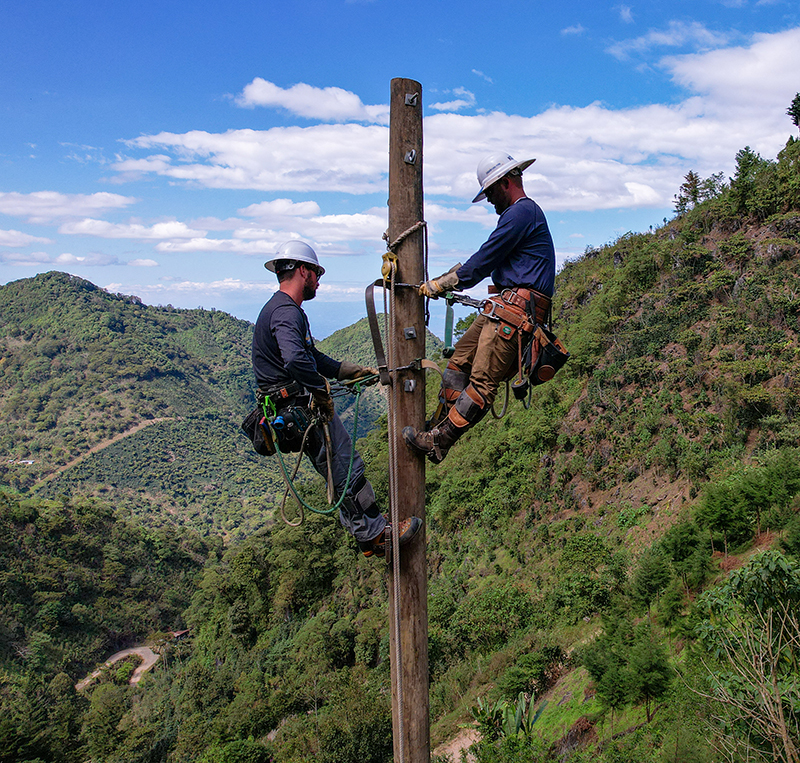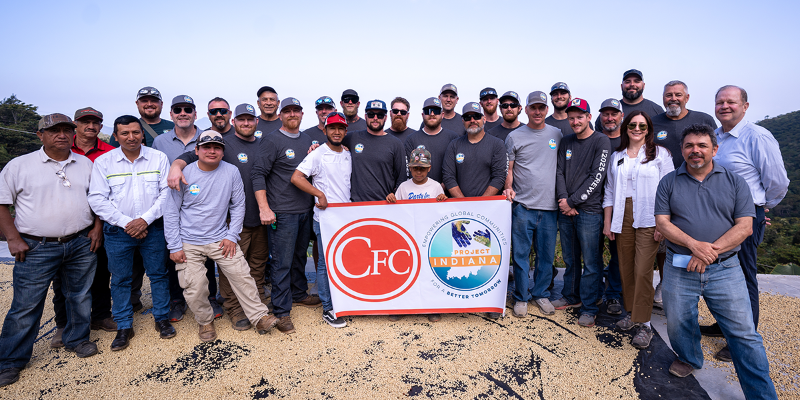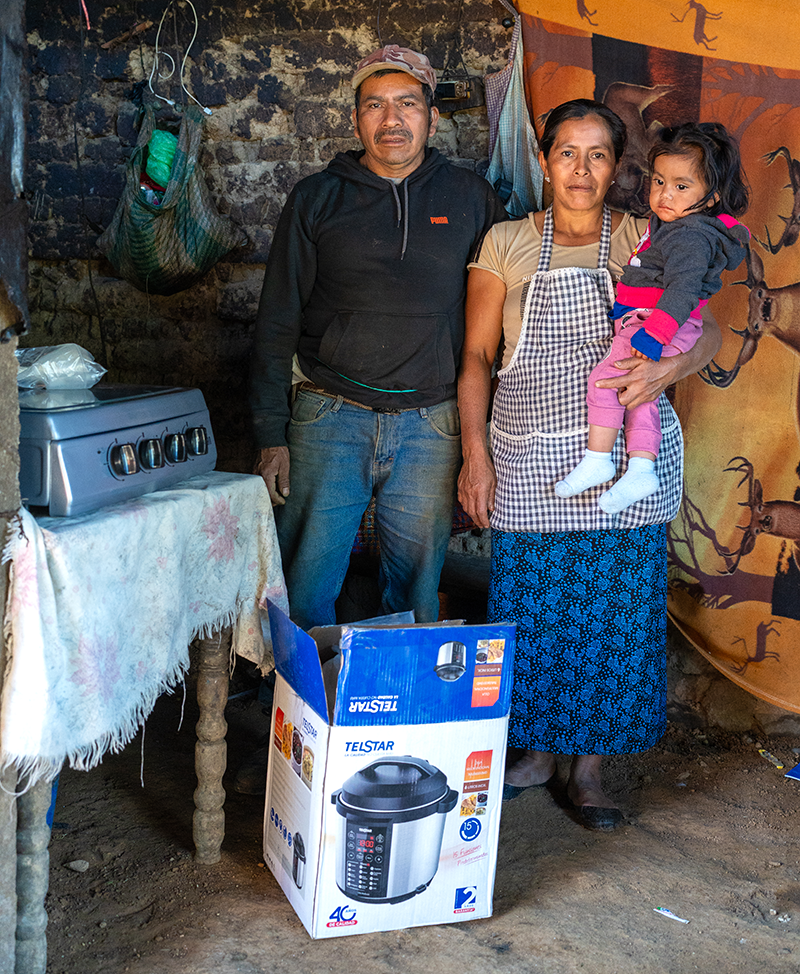CFC Supports Project Indiana Mission to Guatemala
A team of 16 volunteer line workers from 14 Indiana electric cooperatives returned from Guatemala in mid-February after spending two weeks in a rural village building electric line infrastructure and hooking up nearly 200 families to the grid for the very first time. CFC was proud to support the mission, which was coordinated by statewide organization Indiana Electric Cooperatives (IEC) and Project Indiana, a nonprofit organization through which Indiana’s electric cooperatives empower global communities one village at a time. The Indiana team was joined for part of the trip by CFC CEO Andrew Don and CFC Senior Manager of Financial Tools and Analysis Carolina Park, who also serves as a Project Indiana board member.
This was Project Indiana’s sixth mission to Guatemala since 2012.
“When the United Nations designated 2012 as the International Year of the Cooperative, Indiana’s electric cooperatives responded by coordinating a statewide international electrification project in Guatemala,” IEC Vice President of Communication Amanda Barth explained. “Indiana was the first to undertake a project as a single state. Before that, projects were comprised of volunteers from a variety of states. As we jumped into the 2012 project, we did not plan for this to be an ongoing initiative. However, lives were changed both in Guatemala and in Indiana, and this became a passion project for Indiana’s electric cooperatives.”
Over the years, the impact of Project Indiana in Guatemala has grown beyond just bringing first-time electricity to rural villages.
“Maintaining a focus in one country has allowed us to help the areas we’ve electrified beyond simply building electric infrastructure,” Barth said. “For example, we’ve helped fund an intermediate school that allows students to attend classes beyond sixth grade. We’ve been able to work with cooperative boards and staff on education to help them adopt the cooperative business model for their distribution system.”
Project Indiana has been to Guatemala so often that they now maintain a storage unit in the country for tools and equipment used in the various project builds.
When the Indiana team arrived in the village of Palmira for the latest project, they quickly set to work.
In this area of western Guatemala, a coffee growing region with many villages involved in the coffee industry, the altitude was not a significant issue. But the line workers were still on a low mountain and had to adjust to the difference in terrain from the relatively flat Midwest plains they were used to.
“There were line spans across deep valleys, very narrow dirt roads and a lot of climbing up and down hills and poles,” Barth said. “They also didn’t have access to modern equipment like digger or bucket trucks, so work had to be done manually.”

The small, local cooperative utility, Coopeffa R.L., which was formed in 2016, worked with the Indiana team and will maintain the system going forward. They also made sure the poles were set before the team’s arrival. The villagers also helped.
“The villagers worked right alongside our project crew doing whatever was needed, including clearing brush, pulling line through difficult terrain or acting as groundmen,” Barth said. “There was even a 10-year-old boy named Billy who helped one of our wiring crews. He lived with his mom, stepfather and family in one of the first homes our crews wired. Our crew quickly embraced him and he tagged along as they wired each home. At the conclusion of the trip, our crew members gave him his own tools.”

Like many remote villages, Palmira does not have access to the Guatemalan national power grid, so power must come either from an isolated generating unit or, in this case, the Mexican power grid, since the village is near the Mexico border.
Project Indiana = Project Success
Over the course of two weeks, the team built 3 miles of line across 75 poles, hoisted seven transformers and made multiple connections to existing transformers. They also wired the inside of each home with several light fixtures and outlets.
“When we departed Indiana, we planned to electrify 109 homes,” Barth said. “The crew far exceeded everyone’s expectations and electrified 197 homes and a restaurant! This was our largest project to date.”
With electricity, the villagers now can live a better life.
“The foundation of an improved quality of life starts with electricity,” Barth said. “With a refrigerator, they can improve their diet. Malnutrition is common in this region of the world because a nutritious diet is simply out of reach without refrigeration. Refrigeration also makes treatments for common medical conditions possible, such as for those who are insulin dependent. With a light in their homes, education is possible after dark for both the children and adults.”
But the benefits of a project like this don’t accrue only to the villagers. The line workers experienced it, too.
“The feeling that comes to you when you bring light to someone who has never had it before is the reason why we keep coming back to these projects,” Matt Bassett of Tipmont said. “That’s the whole reason we’re in this business is to bring light to people. And to do that for someone for the very first time is a pretty incredible feeling.”
Jimmy Applegate, from Southern Indiana Power, shared: “The most rewarding part of this trip for me was we went and wired up a house early one morning and then drove off and went on with our day. When we were heading back at the end of the day, we looked down over the hill, and someone had a light on there that had never had it before. And come to find out they had already bought a refrigerator and had it down at their house. So, to see instant results like that, was so gratifying, to know that we affected someone’s life in a positive way. It’s something I’m going to take with me for the rest of my life.”
Joe Banfield, from Tipmont, was witness to a very special moment: “We had a 105-year-old woman, the sweetest lady you could ever meet, didn’t have a care in the world; when she flipped that switch on, she was bawling, hugging me, crying, trying to express a lot of stuff in Spanish that I didn’t fully understand, but she was giving her heart to us and what we did for her life. That was awesome.”
“Life-changing” was a phrase many participants used.
Kevin Bay, from Johnson County REMC, said: “Bringing electricity to families for the first time is awesome to watch. It’s something we thought we would never be able to do for somebody. At home, they grew up with electricity. Here, they didn’t have that, and it’s amazing to see them get it, but also to know that it’s not just this family, it’s for generations to come. That’s what’s inspiring about it.”
Summing it all up, Paul Trenkamp, from Decatur County REMC, said: “Working back at home, we’re maintaining people’s lives. With this project, we’re changing people’s lives. It really doesn’t compare.”
CFC Support Helps Make It Happen
Since 2017, CFC and NCSC have helped finance 30 international electrification projects undertaken by 18 states. Over the years, CFC and NCSC have contributed more than $2 million in support of those missions.
“We are very grateful for CFC’s support of Project Indiana,” Barth said. “CFC’s support helped ease the financial burden on our member cooperatives in a very tough economic climate for the industry. CFC’s grant assisted with the purchase of the supplies, crew member hotel rooms and meals in Guatemala, rental vehicles and many other things.”
Barth noted the other very valuable component of CFC’s participation in this project was having the expertise of Andrew Don and Carolina Park on the trip.
 Andrew Don works with the Coopeffa R.L. board.
Andrew Don works with the Coopeffa R.L. board.
While in Guatemala, Don and Park met with Coopeffa R.L.’s board and staff to counsel them on the cooperative business model and how to make the most of that model in operating their small utility. They also were able to meet with Guatemalan dignitaries, including the minister of energy, to express their support for the use of the cooperative business model in electrifying the rest of the country.
“We want to support our member electric cooperatives to undertake these international projects,” Don said. “It's a big endeavor putting a project like this together. They just need a little financial help. It’s the sixth cooperative principle: cooperation among cooperatives. And helping communities like the village of Palmira, is also very important,” Don added. “It made a big impact on me to visit the village and see similar situations to what many rural Americans probably faced 90 years ago.”
While electrifying the village was the primary goal, that was not the only benefit.
“Electricity brings economic prosperity,” Don explained. “With electricity, you can create a better way of life. For the line workers, they’re able to see how it’s making a huge difference in somebody's life. That was one of the biggest takeaways for me, seeing how the experience resonated with them.”
Park noted that while turning on a light and charging a cell phone are big milestones, the real impact lies in the long-term progress this can bring to the village.
“There were some line workers that bought a refrigerator for an elderly woman, and that small act will make a meaningful difference,” Park said. “She and her family were already thinking about making frozen treats to sell, an early sign of how access to electricity can spark new opportunities. For women in particular, tools like Instant Pots will help reduce the time spent cooking, allowing them to focus on other productive activities that benefit their families and the community. With electricity now available, I believe it will transform their economy, health and education in powerful ways.”

Barth concluded: “In the end, it’s not only light that Project Indiana brings. It’s life, hope, progress and opportunities. And it brings full circle what happened in the 1930s here in rural Indiana—people working together to light a community, one pole at a time, to make a better life.”